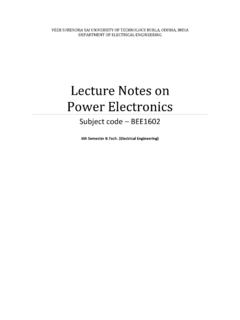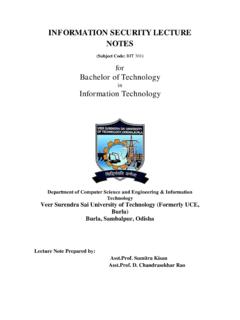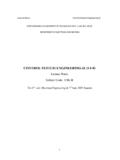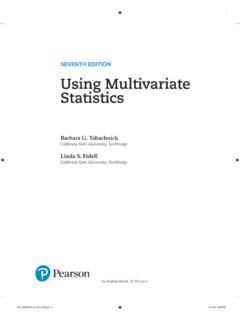Transcription of LECTURE NOTES ON DATA MINING& DATA …
1 DEPT OF CSE & IT VSSUT, Burla LECTURE NOTES ON data mining & data WAREHOUSING COURSE CODE:BCS-403 DEPT OF CSE & IT VSSUT, Burla SYLLABUS: Module I data mining overview, data Warehouse and OLAP Technology, data Warehouse Architecture, Stepsfor the Design and Construction of data Warehouses, A Three-Tier data WarehouseArchitecture,OLAP,OLAP queries, metadata repository, data Preprocessing data Integration and Transformation, data Reduction, data mining Primitives:What Defines a data mining Task?
2 Task-Relevant data , The Kind of Knowledge to be Mined,KDD Module II mining Association Rules in Large Databases, Association Rule mining , Market BasketAnalysis: mining A Road Map, The Apriori Algorithm: Finding Frequent Itemsets Using Candidate Generation,Generating Association Rules from Frequent Itemsets, Improving the Efficiently of Apriori, mining Frequent Itemsets without Candidate Generation, Multilevel Association Rules, Approaches toMining Multilevel Association Rules, mining Multidimensional Association Rules for Relational Database and data Warehouses,Multidimensional Association Rules, mining Quantitative Association Rules, MiningDistance-Based Association Rules, From Association mining to Correlation Analysis Module III What is Classification?
3 What Is Prediction? Issues RegardingClassification and Prediction, Classification by Decision Tree Induction, Bayesian Classification, Bayes Theorem, Na ve Bayesian Classification, Classification by Backpropagation, A Multilayer Feed-Forward Neural Network, Defining aNetwork Topology, Classification Based of Concepts from Association Rule mining , OtherClassification Methods, k-Nearest Neighbor Classifiers, GeneticAlgorithms, Rough Set Approach, Fuzzy Set Approachs, Prediction, Linear and MultipleRegression, Nonlinear Regression, Other Regression Models, Classifier Accuracy Module IV What Is Cluster Analysis, Types of data in Cluster Analysis,A Categorization of Major Clustering Methods, Classical Partitioning Methods: k-Meansand k-Medoids, Partitioning Methods in Large Databases: From k-Medoids to CLARANS, Hierarchical Methods, Agglomerative and Divisive Hierarchical Clustering,Density-BasedMethods, Wave Cluster: Clustering Using Wavelet Transformation, CLIQUE:Clustering High-Dimensional Space, Model-Based Clustering Methods, Statistical Approach,Neural Network Approach.
4 DEPT OF CSE & IT VSSUT, Burla Chapter-1 What Is data mining ? data mining refers to extracting or mining knowledge from large amountsof data . The term is actually a misnomer. Thus, data miningshould have been more appropriately named as knowledge mining which emphasis on mining from large amounts of data . It is the computational process of discovering patterns in large data sets involving methods at the intersection of artificial intelligence, machine learning, statistics, and database systems. The overall goal of the data mining process is to extract information from a data set and transform it into an understandable structure for further use.
5 The key properties of data mining are Automatic discovery of patterns Prediction of likely outcomes Creation of actionable information Focus on large datasets and databases The Scope of data mining data mining derives its name from the similarities between searching for valuable business information in a large database for example, finding linked products in gigabytes of store scanner data and mining a mountain for a vein of valuable ore. Both processes require either sifting through an immense amount of material, or intelligently probing it to find exactly where the value resides. Given databases of sufficient size and quality, data mining technology can generate new business opportunities by providing these capabilities: DEPT OF CSE & IT VSSUT, Burla Automated prediction of trends and behaviors.
6 data mining automates the process of finding predictive information in large databases. Questions that traditionally required extensive hands-on analysis can now be answered directly from the data quickly. A typical example of a predictive problem is targeted marketing. data mining uses data on past promotional mailings to identify the targets most likely to maximize return on investment in future mailings. Other predictive problems include forecasting bankruptcy and other forms of default, and identifying segments of a population likely to respond similarly to given events. Automated discovery of previously unknown patterns. data mining tools sweep through databases and identify previously hidden patterns in one step.
7 An example of pattern discovery is the analysis of retail sales data to identify seemingly unrelated products that are often purchased together. Other pattern discovery problems include detecting fraudulent credit card transactions and identifying anomalous data that could represent data entry keying errors. Tasks of data mining data mining involves six common classes of tasks: Anomaly detection (Outlier/change/deviation detection) The identification of unusual data records, that might be interesting or data errors that require further investigation. Association rule learning (Dependency modelling) Searches for relationships between variables. For example a supermarket might gather data on customer purchasing habits.
8 Using association rule learning, the supermarket can determine which products are frequently bought together and use this information for marketing purposes. This is sometimes referred to as market basket analysis. Clustering is the task of discovering groups and structures in the data that are in some way or another "similar", without using known structures in the data . Classification is the task of generalizing known structure to apply to new data . For example, an e-mail program might attempt to classify an e-mail as "legitimate" or as "spam". Regression attempts to find a function which models the data with the least error. DEPT OF CSE & IT VSSUT, Burla Summarization providing a more compact representation of the data set, including visualization and report generation.
9 Architecture of data mining A typical data mining system may have the following major components. 1. Knowledge Base: This is the domain knowledge that is used to guide the search orevaluate the interestingness of resulting patterns. Such knowledge can include concepthierarchies, DEPT OF CSE & IT VSSUT, Burla used to organize attributes or attribute values into different levels of abstraction. Knowledge such as user beliefs, which can be used to assess a pattern s interestingness based on its unexpectedness, may also be included. Other examples of domain knowledge are additional interestingness constraints or thresholds, and metadata ( , describing data from multiple heterogeneous sources).
10 2. data mining Engine: This is essential to the data mining systemand ideally consists ofa set of functional modules for tasks such as characterization, association and correlationanalysis, classification, prediction, cluster analysis, outlier analysis, and evolutionanalysis. 3. Pattern Evaluation Module: This component typically employs interestingness measures interacts with the data mining modules so as to focus thesearch toward interesting patterns. It may use interestingness thresholds to filterout discovered patterns. Alternatively, the pattern evaluation module may be integratedwith the mining module, depending on the implementation of the datamining method used.












